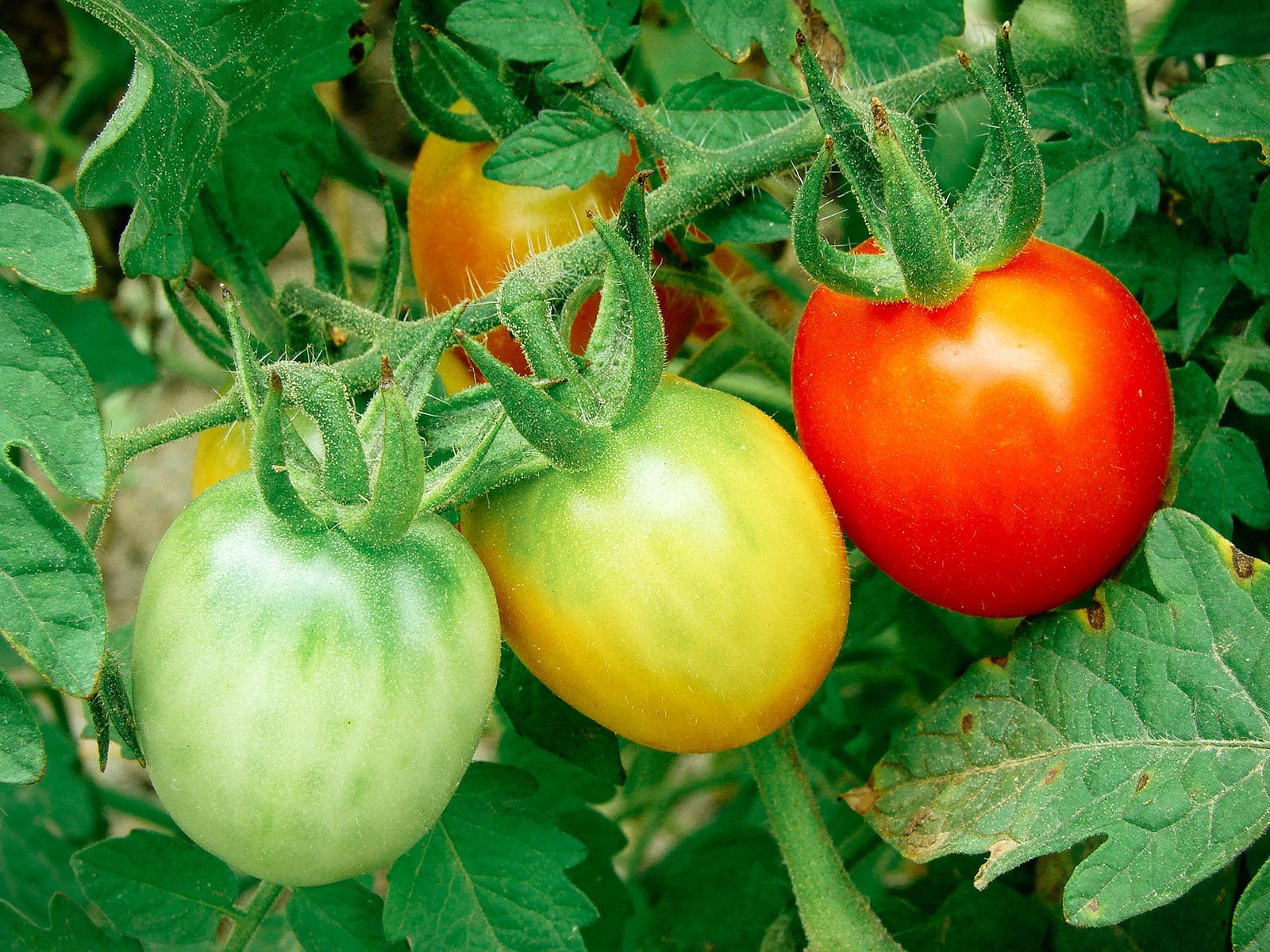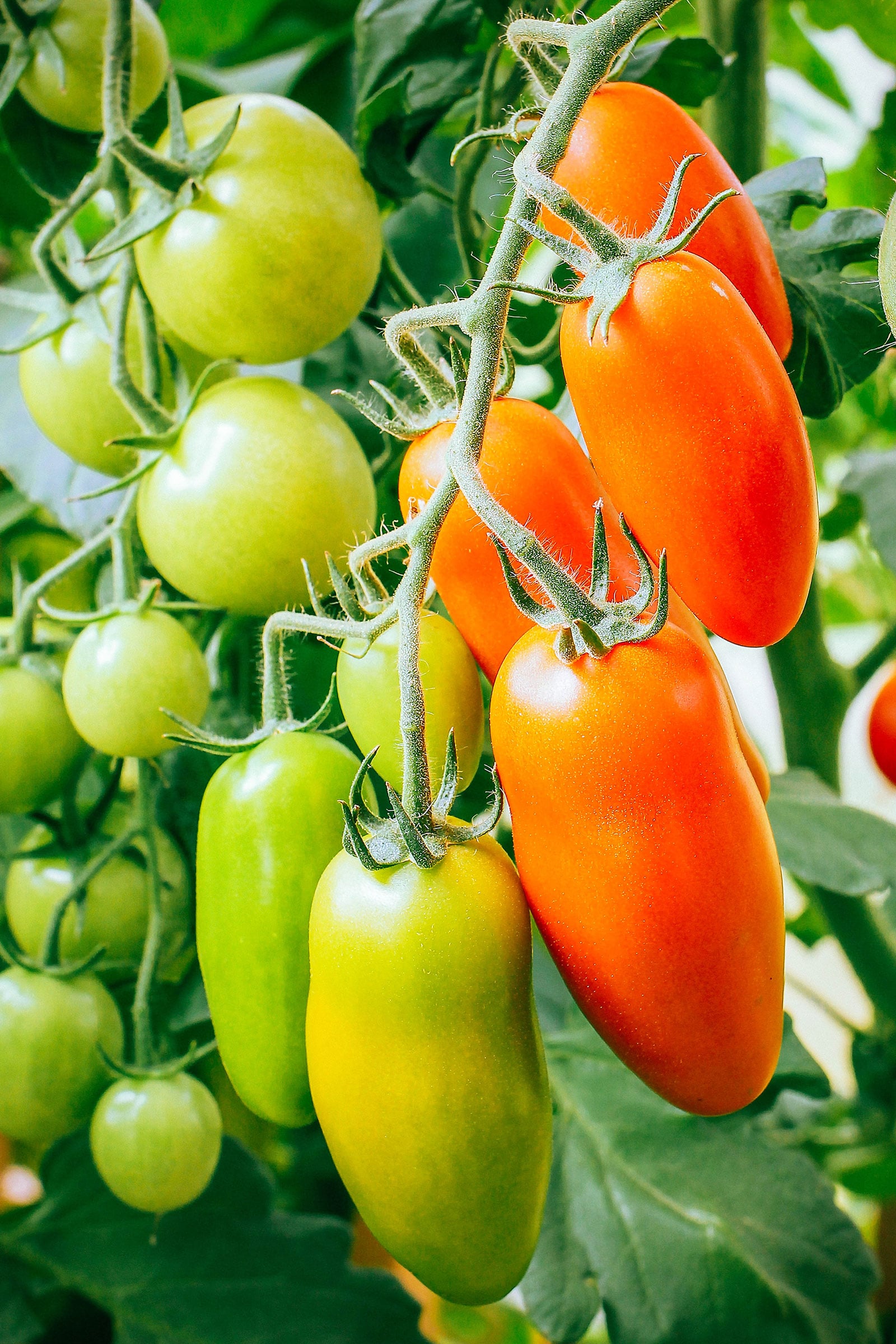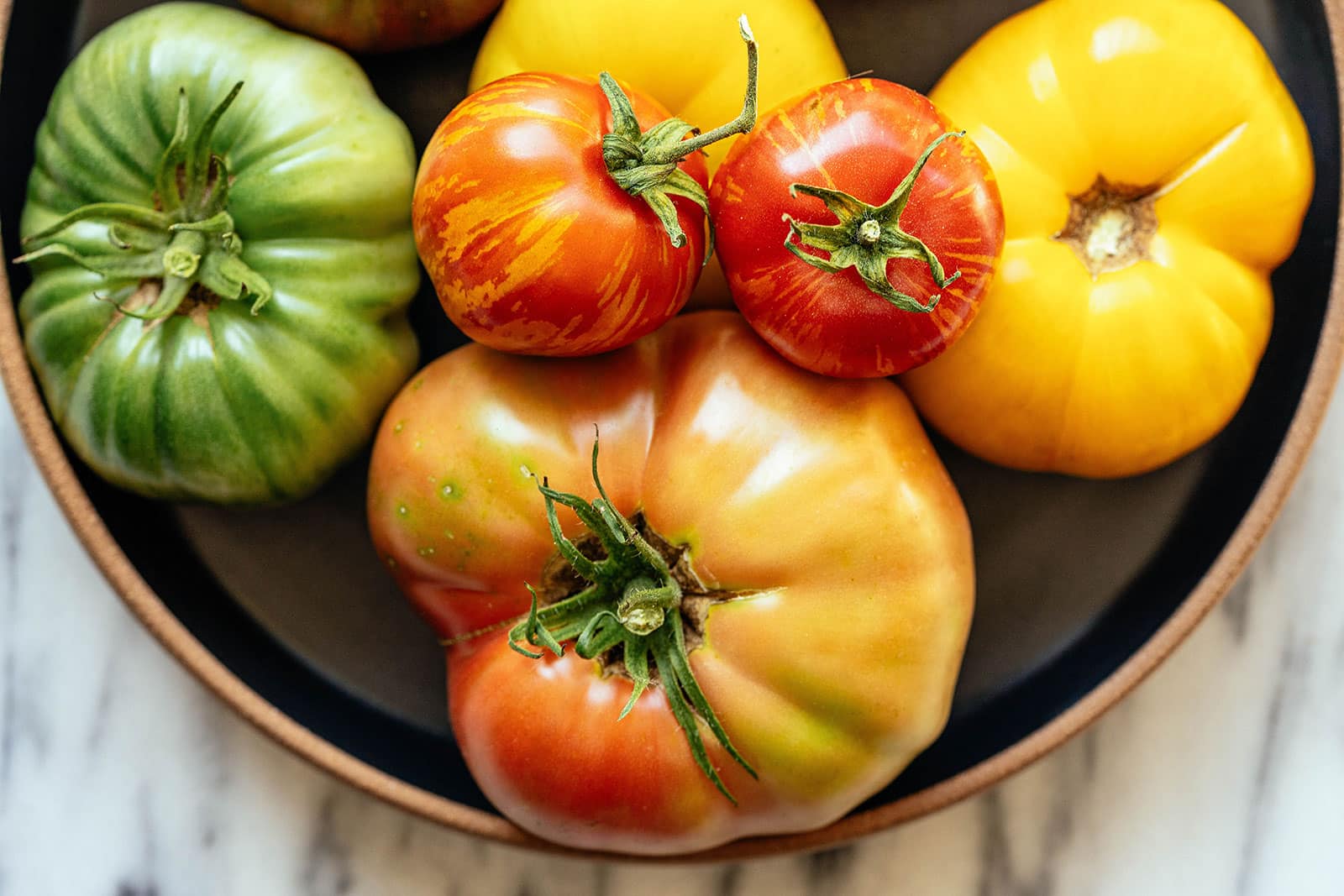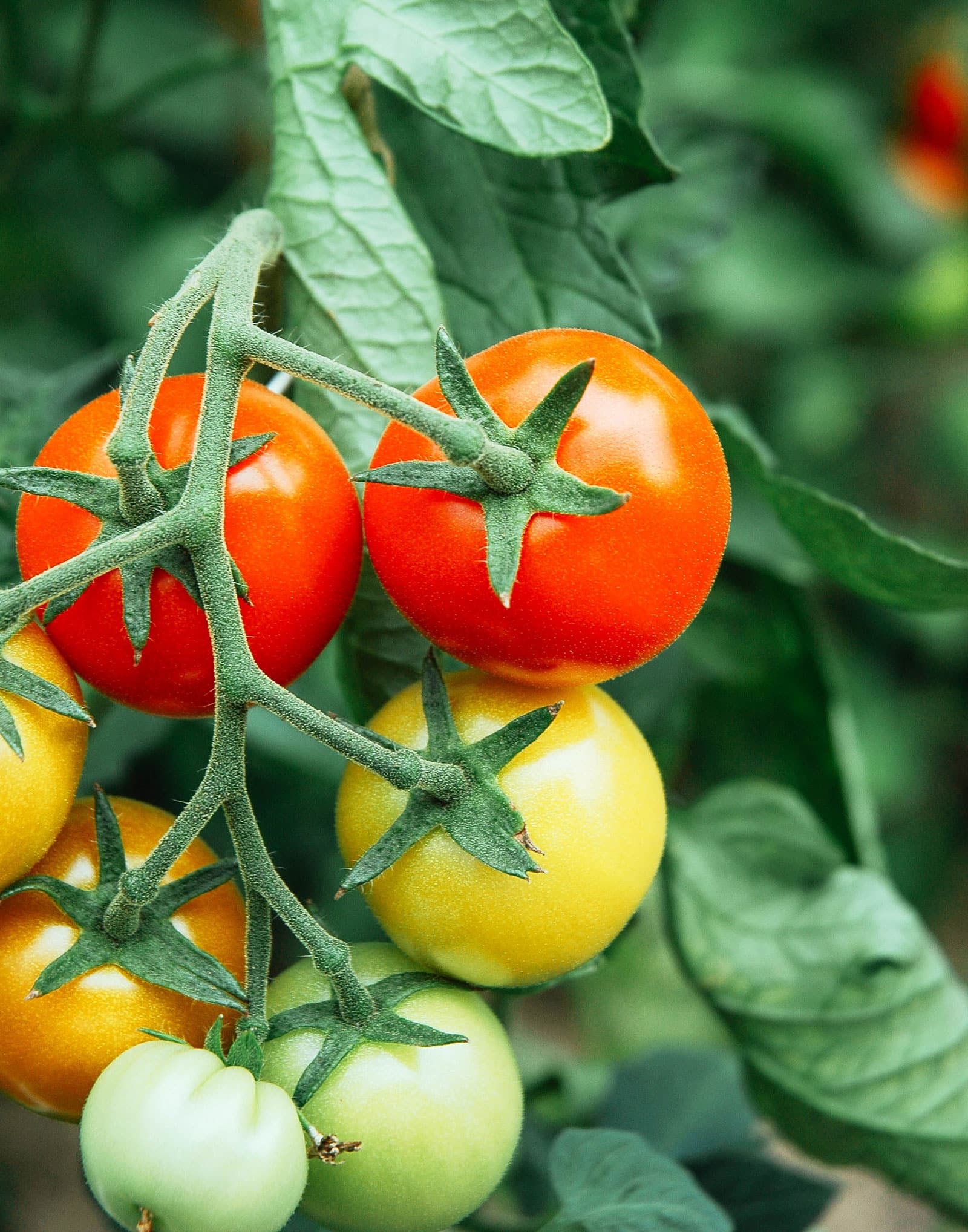If you were asked when’s the best time to pick tomatoes, you would—naturally—say when they’re fully ripe, right?
But wait!
While it’s reasonable to assume that fruits are at their fullest flavor when allowed to ripen on the vine, it’s not necessarily the best time to harvest them. And I’ll explain why (along with my advice for when you should pick tomatoes if you want peak flavor, nutrition, and quality).

The 3 stages of tomato ripening
First, let’s talk about ripening and what happens to a tomato as it goes through this process.
As I previously mentioned in this post on how long it takes for tomatoes to fully ripen, the amount of time for a mature green tomato to turn red (or whatever its mature color will be) is anywhere from four to eight weeks, depending on the type of tomato and its growing conditions.
Once a tomato fruit forms, it goes through several color changes in the ripening process (as seen in this tomato color classification chart from the USDA).

I characterize these changes as three stages:
Stage 1: Mature green tomatoes
Mature green tomatoes have grown to full size, but their flavor is still developing.
They start out in the self-explanatory “green” stage (which ranges from light green to dark green, depending on cultivar) before phasing into the “breakers” stage (where you can begin to see a slight break in color happening).
At this point, the tomato is fully green or has less than 10 percent color (with the break appearing tannish or yellowish, and perhaps a tinge of pink on the surface).
Most commercially grown tomatoes are picked at this stage so they can start to ripen during their long commute to the grocery store (without getting too mushy by the time they land in the display case).
Stage 2: Turning tomatoes
Turning tomatoes—or what I like to call blushing tomatoes—begin to show a definite change of color from green to greenish-yellow, pink, red, or any combination thereof.
When a tomato is “turning,” it has more than 10 percent (but less than 30 percent) color. A subtle blush, if you will.
After another week or two, the tomato moves into the “pink” stage, where the surface shows 30 to 60 percent pink or red.
Stage 3: Vine-ripened tomatoes
Ahhh, this is where most people start to get excited!
Tomatoes in the “light red” stage have more than 60 percent color on the surface. They’re almost fully pink or red and feel a touch softer, though not quite soft enough to be considered ripe.
Once the tomato has more than 90 percent color and is completely red (or orange or yellow or purple—whatever its mature color is), then it’s at peak flavor and texture. Not too soft, not too firm, and just right for fresh eating.
Let it sit in the sun for a bit, and I think we can all agree that a sun-warmed, vine-ripened tomato is heavenly!
So the best time to pick a tomato is…
Looking at the chart (here it is again), it’s clear that the best time to pick a tomato is in the “red” stage, as that’s when the color is deepest, the sugar content is highest, and the flesh is perfectly juicy.

But did you know that you don’t need to reach this stage on the vine?!
Contrary to popular belief, a homegrown vine-ripened tomato isn’t superior to a homegrown indoor-ripened tomato.
Our own psychological biases may have us think otherwise, but as long as a green tomato is mature (grown to full size), it doesn’t matter if it ripens indoors or outdoors.
That said, a mature green tomato has the best chances of ripening if it’s at least picked in the “breakers” stage, as sometimes it’s hard to tell when a green tomato is fully grown.
But unless you’re trying to beat the first frost, you can let your tomatoes continue developing into the “turning,” “pink,” or “light red” stage before you harvest them to finish ripening inside.
At any of these stages (when the fruit is still partially green), a tomato can be ripened off the vine with no loss of flavor, nutrition, or quality.

But why would you pick a tomato early instead of letting it ripen on the vine?
For a few reasons:
- Tomatoes can quickly go from ripe to overripe before you get a chance to pick or eat them all. Harvesting the half-ripe fruits when you’re already in the garden assures that your tomatoes won’t get too mushy before you can use them.
- Pests love those sweet, soft, juicy fruits as much as you do, and leaving your tomatoes to fully ripen on the vines exposes them to birds, squirrels, raccoons, or other wildlife that may take a nibble before you do.
- A sudden rainstorm can cause that perfect tomato to crack or split as the fruit expands faster than its skin can stretch. This most often happens when there’s a heavy rain after a period of relatively dry weather.
- A heat wave can also lead to tomatoes cracking or splitting, as you’re more inclined to water frequently and more heavily while your tomatoes struggle to take up more water than they can handle.
- Very hot weather above 85°F slows down the ripening process, so your tomatoes stay green for much longer than you’d like.
As someone who gardens in a finicky climate with a short season, it’s just not worth the risk in my book.
So, I tend to pick tomatoes before they’re ripe and let them fully ripen to the “red” stage over the course of a week or two on my counter, as it buys me some time before I can use them all.

It also allows me to pull all my tomato plants sooner (if I want to transplant fall seedlings in their place or start a new round of fast-growing vegetables) and relieves the stress of waiting foreverrrr for those tomatoes to ripen before a freeze happens.
If you’ve faced the same quandary, pick with confidence while your tomatoes are in the “breakers” through “pink” stages, knowing your tomatoes will be every bit as good as if you left them on the vine (and without worry of a hungry critter getting to your crop first).
More tomato growing posts to explore:
- Grow Tomatoes Like a Boss With These 10 Easy Tips
- How to Grow Tomatoes in Pots—Even Without a Garden
- How to Best Fertilize Tomatoes for the Ultimate Bumper Crop
- How to Repot Tomato Seedlings for Bigger and Better Plants
- Why and How to Transplant Tomatoes (a Second Time)
- Planting Tomatoes Sideways: How Growing in a Trench Results In Bigger Healthier Plants
- Florida Weave: A Better Way to Trellis Tomatoes
- Conquer Blossom End Rot and Save the Harvest
- Can You Eat Tomato Leaves? The Answer Will Surprise You
- Why Tomato Leaves Have That Unique Smell
- The Power of Fermenting and Saving Tomato Seeds
- 4 Fastest Ways to Ripen Tomatoes in the Garden and Beat the First Frost
- The 30 Best Tasting Heirloom Tomato Varieties (By Color!)
- 83 Fast-Growing Short-Season Tomato Varieties for Cold Climates
- The Best Time to Pick Tomatoes for Peak Quality (It’s Not What You Think!)
















I have to harvest my tomatoes as soon as they are starting to turn, especially the red varieties, because the birds here will happily partake of their early ripening flesh. I lay the unripen tomatoes in the cardboard boxes my cats’ food comes in and they ripen very well. I only grew tomatoes that had come up from tomatoes thrown into our compost tip, this year. Out of 22 tomato bushes only one looks like the ones I bought from the store. Most are yellow tomatoes, which my husband loves, one looked and tasted like a Pineapple tomato, one cherry tomato and several that look like they may be Roma tomatoes. All from seeds out of a tomato that I bought on the vine with it’s sisters at the grocery store. I have really enjoyed growing them this way. I got a better variety than if I had bought expensive plants.
Linda, Great information for gardeners. Is there a way you could set up a way for us to print out all of your great information. It would really help to have a printed copy to use year after year.
Thanks
JB
This is a great idea and a print function or printable PDF has been on my list to look into!
Hi Linda x I hope you’re all enjoying your adventure hold on route 66?!
I am a new gardener and I have followed your growing tomato guide, I love reading about the science behind it as well.
I loved seeing the benefits of potting on for a second time and I save all of your newsletters to re read!
I have grown moneymaker tomatoes here in south west uk ( could have chosen a better variety with hindsight) but they’ve grown well.
A couple of problems I could use a bit of knowledge and advice on, firstly I went away for a week at the end of June and when I got back my daughter was quite poorly in icu hospital so apart from watering the tomatoes I didn’t have time to do much else . The side shoots have grown into branches with flowers on ( luckily I had been removing them up until she was in hospital) so I’ve got 7 plants all with between 5-8 trusses on , I have been taking excess leaves off and any other side shoots that are forming and I have been tying them to the stake etc.
I am having trouble understanding about when and how to pinch out the growing tips of each plant. Am I supposed to only leave on 5 or 6 trusses ( some of mine have quite a few more) . Is that too many?
If I pinch out growing tips and stop them will they still develop more trusses from different places on the plant?
Wouldn’t that reduce yield?
I understand that the plant sends its energy towards the ones already growing but if I pinch it out/off will it grow more trusses ( and would the new truss grow from the same place or in a different place?
I feel a bit dumb asking all this but I really don’t want to jeopardise my chances of success at harvest time.
I hope you have a great holiday and I look forward to your emails.
Rachel x
Here’s what I usually do for my own (indeterminate) tomato plants: I remove the lowest vines that don’t have any flowers, and let all the suckers grow unless they, too, don’t end up producing flowers (at which point I cut off those vines). In my experience, removing non-producing vines seems to tell the plant to send more energy to the flowers and fruits it’s already got (and to stop growing so many leaves). So it doesn’t feel like I’m reducing yield as I allow all suckers to grow as long as they want, as long as they have flowers. Hope that makes sense!
Very good advice. We pick all tomatoes early ahead of a frost, and always pick heirlooms early because they split as they ripen fully outdoors. No birds or insects indoors.